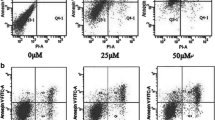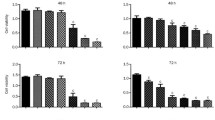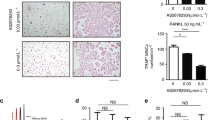Abstract
Besides its preventive action on bone resorption the third generation bisphosphonate zoledronic acid (ZOL) has been shown to display potent inhibitory action on the formation of bone metastases of various human cancers. Recent research also indicates an antitumoral effect on primary tumors and visceral metastases. Here we investigate for the first time the effect of ZOL on the human colon carcinoma cell line HCT-116. ZOL strongly inhibited the proliferation and soft agar colony formation of HCT-116 cells and caused a G1 cell cycle arrest in a population of ZOL treated cells. This cell cycle arrest was accompanied by an induction of apoptosis via a caspase dependent mechanism. Activation of Caspases 3, 7, 8 and 9, cleavage of PARP as well as the release of cytochrome C into the cytosol were detected in HCT-116 cells treated with low micromolar concentrations of ZOL. The induction of the mitochondrial pathway of apoptosis was accompanied by a translocation of Bax into the mitochondria, Bid activation and a decrease of overall Bcl-2 expression. We also detected a cytosolic increase of apoptosis inducing factor (AIF), a trigger of caspase-independent apoptosis. Taken together, our data indicate a potent antitumoral and apoptosis inducing effect of ZOL on HCT-116 colon carcinoma cells.






Similar content being viewed by others
References
Heymann D, Ory B, Gouin F, Green JR, Rédini F (2004) Bisphosphonates: new therapeutic agents for the treatment of bone tumors. Trends Mol Med 10:7. Review
Clézardin P, Fournier P, Boissier S, Peyruchaud O (2003) In vitro and in vivo antitumor effects of bisphosphonates. Curr Med Chem 10:173–180. Review
Goffinet M, Thoulouzan M, Pradines A et al (2006) Zoledronic acid treatment impairs protein geranyl-geranylation for biological effects in prostatic cells. BMC Cancer 6:60
Denoyelle C, Hong L, Vannier JP, Soria J, Soria C (2003) New insights into the actions of bisphosphonate zoledronic acid in breast cancer cells by dual RhoA-dependent and – independent effects. Br J Cancer 88(10):1631–1640
Fromigue O, Kheddoumi N, Body JJ (2003) Bisphosphonates antagonise bone growth factor´s effects on human breast cancer cells survival. Br J Cancer 89(1):178–184
Sohara Y, Shimada H, Scadeng M et al (2003) Lytic bone lesions in human neuroblastoma xenograft involve osteoclast recruitment and are inhibited by bisphosphonate. Cancer Res 63(12):3026–3031
Yuasa T, Kimura S, Ashihara E, Habuchi T, Maekawa T (2007) Zoledronic acid - a multiplicity of anti-cancer action. Curr Med Chem 14(20):2126–2135
Green JR (2004) Bisphosphonates: Preclinical review. Oncologist 9(Suppl 4):3–13. Review
Boissier S, Ferreras M, Peyruchaud O et al (2000) Bisphosphonates inhibit prostate and breast carcinoma cell invasion, an early event in the formation of bone metastases. Cancer Res 60(11):2949–2954
Smith MR (2005) Zoledronic acid to prevent skeletal complications in cancer: corrobating the evidence. Cancer Treat Rev 31(Suppl 3):19–25
Cohen MH, Dagher M, Griebel DJ et al (2002) U.S. food and drug administration drug approval summaries: Imatinib Mesylate, Mesna tablets and Zoledronic Acid. Oncologist 7(5):393–400
Hiraga T, Williams PJ, Ueda A, Tamura D, Yoneda T (2004) Zoledronic acid inhibits visceral metastases in the 4T1/luc mouse breast cancer model. Clin Cancer Res 10(13):4559–4567
Yamagishi S, Abe R, Inagaki Y et al (2004) Minodronate, a newly developed nitrogen-containing bisphosphonate, suppresses melanoma growth and improves survival in nude mice by blocking vascular endothelial growth factor signalling. Am J Pathol 165(6):1865–1874
Giraudo E, Inouer M, Hanahan D (2004) An amino-bisphosphonate targets MMP-9-expressing macrophages and angiogenesis to impair cervical carcinogenesis. J Clin Invest 114(5):623–633
Okuno K (2007) Surgical treatment for digestive cancer. Curr Issu Colon Cancer Dig Surg 24(2):108–114. Review
Reddig PJ, Juliano RL (2005) Clinging to life: cell to matrix adhesion and cell survival. Cancer Metastasis Rev 24(3):425–439. Review
Soldani C, Scovassi AI (2002) Poly(ADP-ribose) polymerase-1 cleavage during apoptosis: an update. Apoptosis 7(4):321–328. Review
Erhart LM, Lankat-Buttgereit B, Schmidt H, Wenzel U, Daniel H, Göke R (2005) Flavone initiates a hierarchical activation of the caspase-cascade in colon cancer cells. Apoptosis 10(3):611–617
Ozoren N, El-Deiry WS (2002) Defining characteristics of Type I and II apoptotic cells in response to TRAIL. Neoplasia 4(6):551–557
Er E, Oliver L, Cartron PF, Juin P, Manon S, Vallette FM (2006) Mitochondria as the target of the pro-apoptotic protein Bax. Biochim Biophys Acta 1757(9–10):1301–1311. Epub 2006 May 27. Review
Ory B, Blanchard F, Battaglia S, Gouin F, Rédini F, Heymann D (2007) Zoledronic acid activates the DNA S-phase checkpoint and induces osteosarcoma cell death characterized by apoptosis-inducing factor and endonuclease-G translocation independently of p53 and retinoblastoma status. Mol Pharmacol 71(1):333–343
Walker K, Olson MF (2005) Targeting Ras and Rho GTPases as opportunities for cancer therapeutics. Curr Opin Genet Dev 15(1):62–68. Review
Li YY, Chang JW, Chou WC, Liaw CC, Wang HM, Huang JS, Wang CH, Yeh KY (2008) Zoledronic acid is unable to induce apoptosis, but slows tumor growth and prolongs survival for non-small-cell lung cancers. Lung Cancer 59(2):180–191
Ho LH, Read SH, Dorstyn L, Lambrusco L, Kumar S (2008) Caspase-2 is required for cell death induced by cytoskeletal disruption. Oncogene [Epub ahead of print]
Hasmim M, Bieler G, Rüegg C (2007) Zoledronate inhibits endothelial cell adhesion, migration and survival through the suppression of multiple, prenylation-dependent signaling pathways. J Thromb Haemost 5(1):166–173
Denoyelle C, Hong L, Vannier JP, Soria J, Soria C (2003) New insights into the actions of bisphosphonate zoledronic acid in breast cancer cells by dual RhoA-dependent and -independent effects. Br J Cancer 88(10):1631–1640
Balan KV, Demetzos C, Prince J, Dimas K, Cladaras M, Han Z, Wyche JH, Pantazis P (2005) Induction of apoptosis in human colon cancer HCT116 cells treated with an extract of the plant product, Chios mastic gum. In vivo 19(1):93–102
Brenner C, Grimm S (2006) The permeability transition pore complex in cancer cell death. Oncogene 25(34):4744–4756. Review. Erratum in: Oncogene. 25(50):6678
Chen M, Guerrero AD, Huang L et al (2007) Caspase-9-induced mitochondrial disruption through cleavage of anti-apoptotic BCL-2 family members. J Biol Chem 282(46):33888–33895
Garrido C, Galluzzi L, Brunet M, Puig PE, Didelot C, Kroemer G (2006) Mechanisms of cytochrome c release from mitochondria. Cell Death Differ 13(9):1423–1433. Epub 2006 May 5. Review
Paradissis A, Hatziantoniou S, Georgopoulos A, Psarra AM, Dimas K, Demetzos C (2007) Liposomes modify the subcellular distribution of sclareol uptake by HCT-116 cancer cell lines. Biomed Pharmacother 61(2–3):120–124
Kosakowska-Cholody T, Cholody WM, Monks A, Woynarowska BA, Michejda CJ (2005) WMC-79, a potent agent against colon cancers, induces apoptosis through a p53-dependent pathway. Mol Cancer Ther 4(10):1617–1627
Fehlberg S, Gregel CM, Göke A, Göke R. Bisphenol A (2003) diglycidyl ether-induced apoptosis involves Bax/Bid-dependent mitochondrial release of apoptosis-inducing factor (AIF), cytochrome c and Smac/DIABLO. Br J Pharmacol 139(3):495–500
Krantic S, Mechawar N, Reix S, Quirion R (2007) Apoptosis-inducing factor: a matter of neuron life and death. Prog Neurobiol 81(3):179–196
Modjtahedi N, Giordanetto F, Madeo F, Kroemer G (2006) Apoptosis-inducing factor: vital and lethal. Trends Cell Biol 16(5):264–272. Epub 2006 Apr 18. Review
Ory B, Heymann MF, Kamijo A, Gouin F, Heymann D, Redini F (2005) Zoledronic acid suppresses lung metastases and prolongs overall survival of osteosarcoma-bearing mice. Cancer 104(11):2522–2529
Ezra A, Golomb G (2000) Administration routes and delivery systems of bisphosphonates for the treatment of bone resorption. Adv Drug Deliv Rev 42(3):175–195. Review
Author information
Authors and Affiliations
Corresponding author
Additional information
Lilian Sewing and Florian Steinberg contributed equally to this work.
Rights and permissions
About this article
Cite this article
Sewing, L., Steinberg, F., Schmidt, H. et al. The bisphosphonate zoledronic acid inhibits the growth of HCT-116 colon carcinoma cells and induces tumor cell apoptosis. Apoptosis 13, 782–789 (2008). https://doi.org/10.1007/s10495-008-0211-z
Published:
Issue Date:
DOI: https://doi.org/10.1007/s10495-008-0211-z




